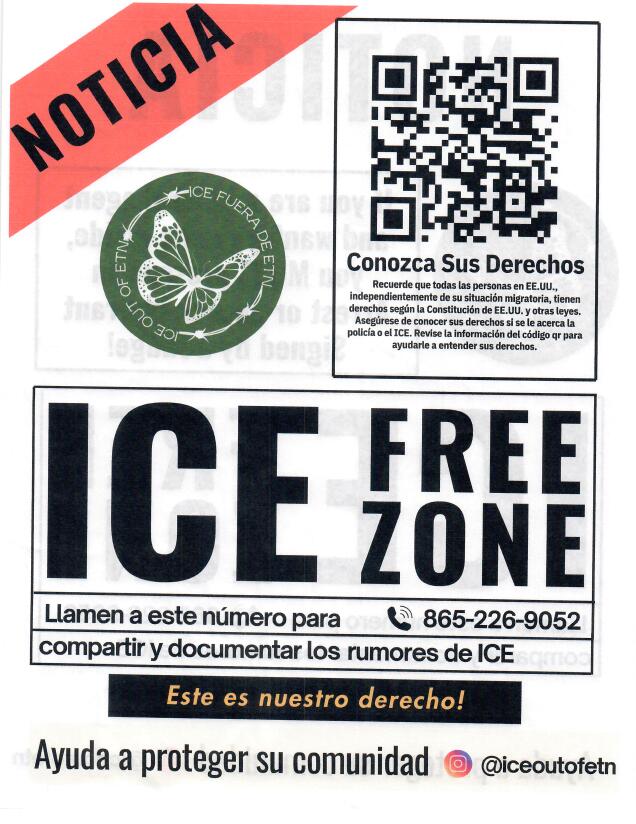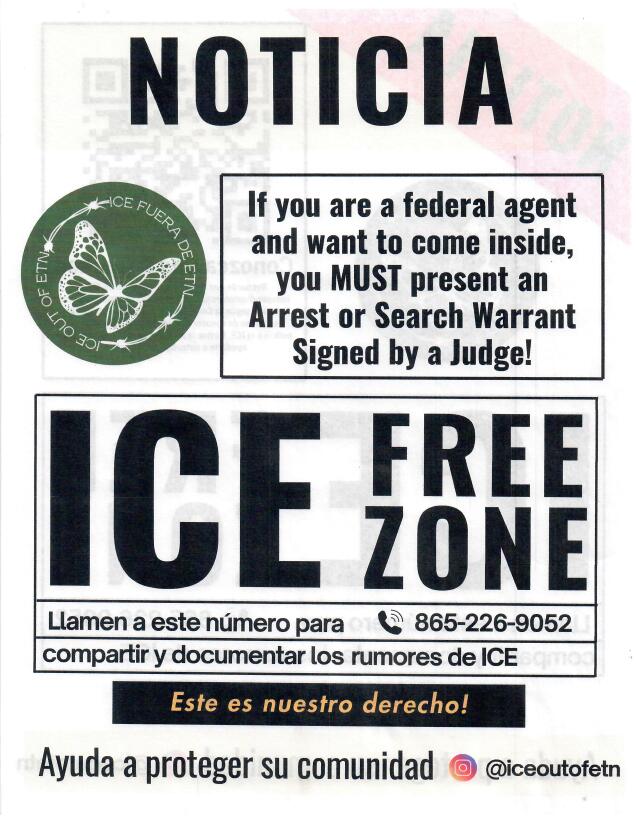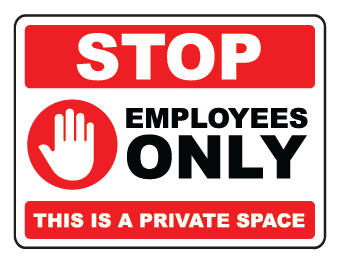MOVING FROM VISIBILITY TO LEVERAGE
There’s no sugarcoating our current situation – the country is in a dangerous moment. But MAGA is not invincible, and We The People ARE standing up.
It’s up to US to shift from visibility to leverage and to bring DOWN the pillars that allowed things to go this far.
It’s up to US to stand together to prove them wrong in thinking some inevitable fatigue will force us into complacency.
It’s up to US to encourage the pillars upholding this administration NOT to capitulate and to stand strong to our long held American values – especially those of freedom, diversity, inclusion, and equality of opportunity.
WE have already taken the initial steps with our initial Nonviolent Noncooperation sessions and committing to our first actions. Now the strategy begins
They never anticipated us changing tactics. This is how wars are won.
RESOURCES – EVERYTHING YOU NEED TO KNOW AS OF PRESENT
INAUGURAL NONVIOLENT NONCOOPERATION SESSIONS
Meeting One
Find the full presentation from the inaugural July 17th meeting here:
Meeting Two
You can find the video from meeting 2 here:
https://share.icloud.com/photos/0e3DLIQU9saiYxQ-LXtGqfYMA
And Dan’s ‘Minutes’:
https://docs.google.com/document/d/1KzHDb2bq2CwjtYI-La89VBQ6RMaJc3_0zGmhz-d7NeA/edit?usp=sharing
Meeting One
Find the full presentation from the inaugural July 17th meeting here:
Meeting Two
You can find the video from meeting 2 here:
https://share.icloud.com/photos/0e3DLIQU9saiYxQ-LXtGqfYMA
And Dan’s ‘Minutes’:
https://docs.google.com/document/d/1KzHDb2bq2CwjtYI-La89VBQ6RMaJc3_0zGmhz-d7NeA/edit?usp=sharing
KNOW YOUR RIGHTS WHEN ICE IS AT YOUR DOOR
Understanding Immigration Enforcement Documents – Warrants and Subpoenas
When dealing with immigration enforcement, it is crucial to understand the differences between judicial and administrative warrants. The U.S. Department of Homeland Security has increased its use of administrative warrants and subpoenas to pressure individuals and organizations into compliance. Knowing how to identify these documents can help protect your rights and prevent unlawful enforcement actions.
What is a Warrant?
A warrant is a legal document authorizing law enforcement to take specific actions, such as conducting a search, making an arrest, or seizing property. There are two primary types of warrants related to immigration enforcement:
- Judicial Warrants – Issued by a court and signed by a judge and the date should be recent otherwise it is considered a stale/old warrant that no longer valid.
- Administrative Warrants – Issued by immigration authorities such as ICE or CBP, but not by a court. Tell ICE or CBP to return when they have a valid judicial warrant signed by a judge.
Key Differences Between Judicial and Administrative Warrants
Feature Judicial Warrant Administrative Warrant Issuing Authority A federal or state court judge ICE, CBP, or USCIS Legal Force Must be complied with Does not require compliance Scope of Authority Grants full legal authority to enter private spaces Does not grant authority to enter private spaces
A critical point: An administrative warrant does not grant ICE or CBP the right to enter private spaces, such as homes or non-public areas of businesses, without consent. If a person opens the door, ICE may state that they were given consent to enter the home or non-public areas of the business.
When can ICE Legally Detain Immigrants?
Warrant Type Allowed Time Judicial Warrant 6 a.m. – 10 p.m. (unless a judge has autorized night service) Administrative Warrant (ICE issued) Any time but they cannot legally force entry into private residences Home Entry Only with a judge signed judicial warrant
Home visits and wellness checks: Any agents or those posing as governement agency workers have made visits to homes with the guise of a wellness check. They cannot enter the home wihout a judicial search warrant signed by a judge. Do not consent to their entry.
Subpoenas: Judicial vs. Administrative
Subpoenas are legal documents requiring individuals or entities to provide testimony or evidence. Like warrants, they can be judicial or administrative.
Feature Judicial Subpoena Administrative Subpoena Issuing Authority A federal or state court judge ICE, CBP, or USCIS officials Legal Force Must be complied with Not immediately enforceable Purpose Requires testimony or document production for court cases Used in immigration investigations to gather information Consequences for Non-Compliance Contempt of court charges May lead to court enforcement but does not carry immediate penalties Example Document U.S. District Court Subpoena DHS Form I-138
If served with an administrative subpoena, you are not legally required to comply unless a federal court orders enforcement.
Example of LEGITIMATE Judicial Warrant
For a Judicial Warrant to be valid, it MUST be issued by a court and signed by a judge within the past 14 days.
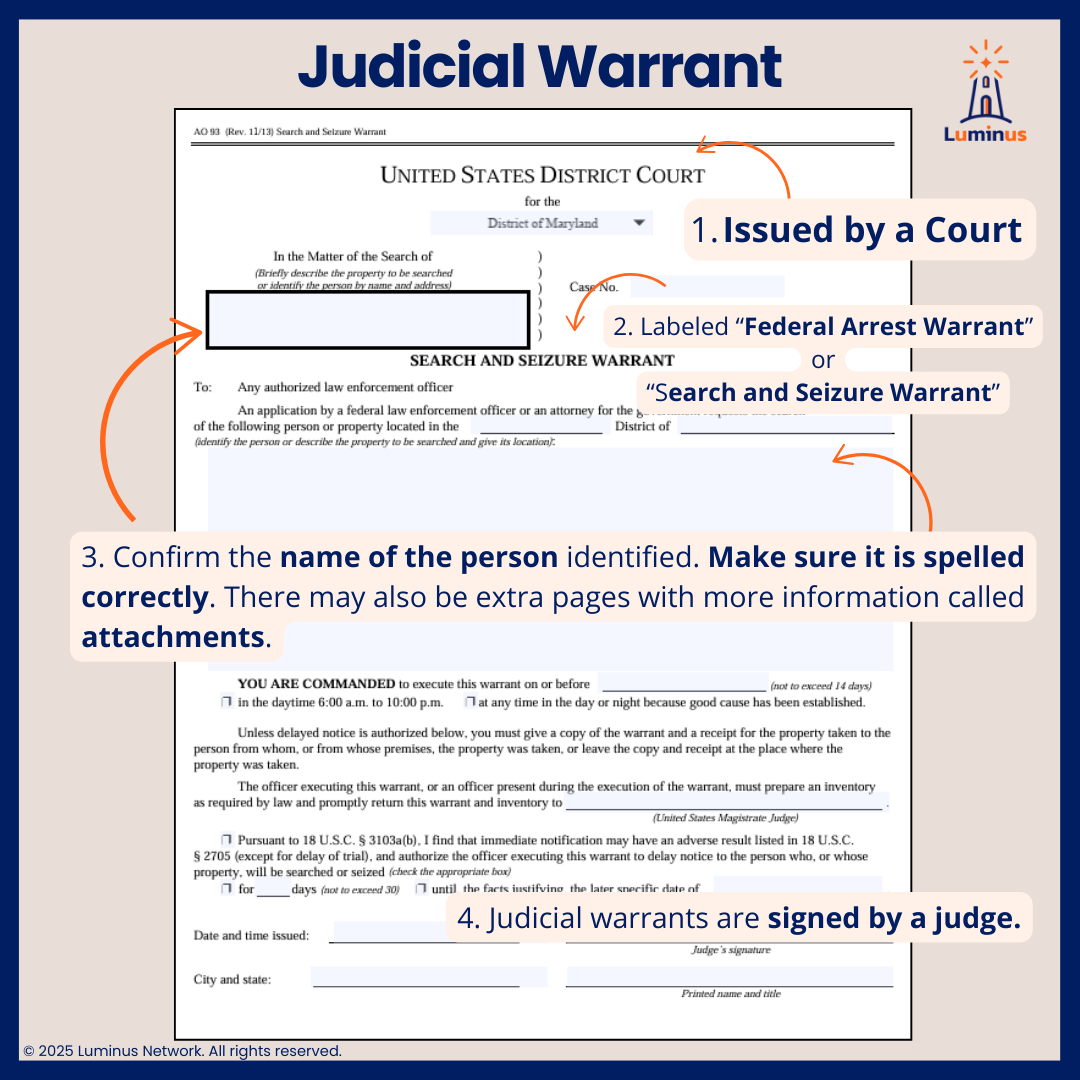
Example of 'Administrative Warrant' - DO NOT COMPLY!
An Administrative Warrant is issued by DHS and NOT signed by a judge.
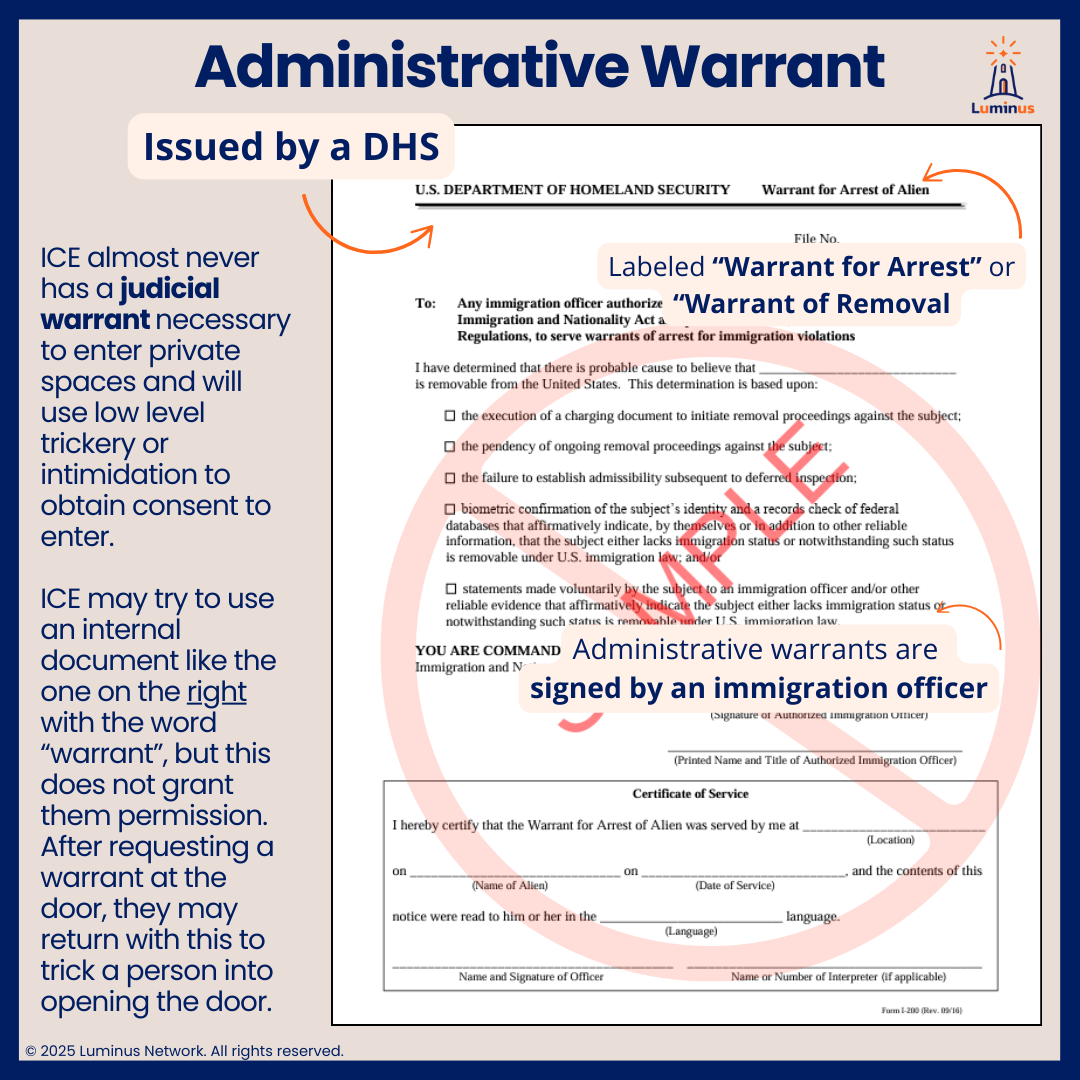
How to Respond If ICE, CBP, or USCIS Comes to Your Door
- Do Not Open the Door – Opening the door can be interpreted as consent to entry. Ask the agents to slide any documents under the door, show them through a window, or present to doorbell camera.
- If you have an attorney – Contact your attorney and, if needed, put them on speakerphone to communicate with ICE through the door.
- Examine the Document Carefully – Determine whether it is a judicial or administrative warrant.
- If it is a judicial warrant, verify that it is signed by a judge, correctly names the person or location, and is within the execution timeframe.
- If it is an administrative warrant, you are not required to comply and may refuse entry.
- Remain Silent – You have the right to remain silent. Do not answer questions about your immigration status or provide any information beyond what is legally required.
- Do Not Sign Anything – Avoid signing any documents presented by immigration officers without first consulting an attorney.
- Document the Encounter – Take notes, record video (if legally permitted in your state), and collect badge numbers or names of the agents.
- Seek Legal Assistance – Contact an immigration lawyer or advocacy organization immediately for guidance.
What If ICE Agents Refuse To Show ID Or Take Off Masks?
According to the ACLU, you can deny entrance even with a warrant the agent shows identification when asked.
As for masks:You can ask an ICE officer to remove their mask during an encounter or before entry, but they are not legally obligated to do so.
No Federal Law or Regulation Requires Unmasking: There is no federal law or regulation that bans or prohibits federal officers, including ICE agents, from wearing masks.ICE Stance: ICE leadership has stated that agents can continue to wear masks in the field, citing safety concerns and threats against officers.
Identification Alternatives: ICE states that agents wear badges and carry credentials with their name and organization, and identify themselves as immigration officers during an arrest or as soon as it is practical and safe.
Some lawmakers have introduced bills aimed at requiring federal agents, including ICE, to be clearly identifiable while on duty, potentially including the removal of masks and displaying identification. We will update this document if that comes to fruition. Protecting Students Against Administrative Immigration Warrants and/or Immigration Subpoenas
Each school has leadership such as principals that should obtain copies of documents and enough informaiton to forward to their central school district’s office to make a determination on next steps if ICE attempts to detain a student. If presented with an administrative warrant or immigration issued subpoena, school deny access to the student and argue compliance with Family Educational Rights and Privacy Act (FERPA). Parents and any emergency contacts should be notified as well from the student’s file.
Protecting Your Rights in Houses of Worship
Houses of worship have historically served as places of sanctuary and support for immigrant communities. While ICE and CBP may attempt enforcement actions in religious institutions, they are still bound by constitutional limitations. Without a judicial warrant, ICE agents cannot enter non-public areas of places of worship. Religious leaders and congregations should be aware of their rights and prepare a response plan, including designating a point of contact, educating members on legal protections, and forming networks with legal advocates to challenge unlawful enforcement actions.
Protecting Your Rights in Health Care Facilities
Under recent policy changes, ICE and CBP can conduct enforcement actions in hospitals and clinics. However, healthcare staff and patients still have rights:
- ICE agents need judicial warrants to enter private patient areas.
- Staff should designate a point of contact to handle law enforcement interactions.
- Facilities should clearly mark private areas to prevent unauthorized entry.
- HIPAA laws protect patient information from being disclosed without a judicial warrant or court order.
Take Action: Be Prepared
- Know Your Rights – (English or Spanish version) Learn how to distinguish between judicial and administrative documents, 4th, 5th, and 6th Amendment Rights, and various other areas to protect yourself and others in the community.
- Train EVERYONE including Staff, Community Leaders and Members – Educate those around you on how to respond to enforcement actions.
- Establish a Response Plan – Work with attorneys to create policies for handling ICE and CBP interactions.
- Some good sources for creating plans:
- Engage in Public Advocacy – Pressure local governments to adopt sanctuary policies and push back against aggressive enforcement tactics.
- Find Legal Help – Contact Luminus or search Immigration Advocates Network for immigration legal nonprofits in your area.
Understanding Immigration Enforcement Documents – Warrants and Subpoenas
When dealing with immigration enforcement, it is crucial to understand the differences between judicial and administrative warrants. The U.S. Department of Homeland Security has increased its use of administrative warrants and subpoenas to pressure individuals and organizations into compliance. Knowing how to identify these documents can help protect your rights and prevent unlawful enforcement actions.
What is a Warrant?
A warrant is a legal document authorizing law enforcement to take specific actions, such as conducting a search, making an arrest, or seizing property. There are two primary types of warrants related to immigration enforcement:
- Judicial Warrants – Issued by a court and signed by a judge and the date should be recent otherwise it is considered a stale/old warrant that no longer valid.
- Administrative Warrants – Issued by immigration authorities such as ICE or CBP, but not by a court. Tell ICE or CBP to return when they have a valid judicial warrant signed by a judge.
Key Differences Between Judicial and Administrative Warrants
| Feature | Judicial Warrant | Administrative Warrant |
|---|---|---|
| Issuing Authority | A federal or state court judge | ICE, CBP, or USCIS |
| Legal Force | Must be complied with | Does not require compliance |
| Scope of Authority | Grants full legal authority to enter private spaces | Does not grant authority to enter private spaces |
A critical point: An administrative warrant does not grant ICE or CBP the right to enter private spaces, such as homes or non-public areas of businesses, without consent. If a person opens the door, ICE may state that they were given consent to enter the home or non-public areas of the business.
When can ICE Legally Detain Immigrants?
| Warrant Type | Allowed Time |
| Judicial Warrant | 6 a.m. – 10 p.m. (unless a judge has autorized night service) |
| Administrative Warrant (ICE issued) | Any time but they cannot legally force entry into private residences |
| Home Entry | Only with a judge signed judicial warrant |
Home visits and wellness checks: Any agents or those posing as governement agency workers have made visits to homes with the guise of a wellness check. They cannot enter the home wihout a judicial search warrant signed by a judge. Do not consent to their entry.
Subpoenas: Judicial vs. Administrative
Subpoenas are legal documents requiring individuals or entities to provide testimony or evidence. Like warrants, they can be judicial or administrative.
| Feature | Judicial Subpoena | Administrative Subpoena |
| Issuing Authority | A federal or state court judge | ICE, CBP, or USCIS officials |
| Legal Force | Must be complied with | Not immediately enforceable |
| Purpose | Requires testimony or document production for court cases | Used in immigration investigations to gather information |
| Consequences for Non-Compliance | Contempt of court charges | May lead to court enforcement but does not carry immediate penalties |
| Example Document | U.S. District Court Subpoena | DHS Form I-138 |
If served with an administrative subpoena, you are not legally required to comply unless a federal court orders enforcement.
Example of LEGITIMATE Judicial Warrant
For a Judicial Warrant to be valid, it MUST be issued by a court and signed by a judge within the past 14 days.
Example of 'Administrative Warrant' - DO NOT COMPLY!
An Administrative Warrant is issued by DHS and NOT signed by a judge.
How to Respond If ICE, CBP, or USCIS Comes to Your Door
- Do Not Open the Door – Opening the door can be interpreted as consent to entry. Ask the agents to slide any documents under the door, show them through a window, or present to doorbell camera.
- If you have an attorney – Contact your attorney and, if needed, put them on speakerphone to communicate with ICE through the door.
- Examine the Document Carefully – Determine whether it is a judicial or administrative warrant.
- If it is a judicial warrant, verify that it is signed by a judge, correctly names the person or location, and is within the execution timeframe.
- If it is an administrative warrant, you are not required to comply and may refuse entry.
- If it is a judicial warrant, verify that it is signed by a judge, correctly names the person or location, and is within the execution timeframe.
- Remain Silent – You have the right to remain silent. Do not answer questions about your immigration status or provide any information beyond what is legally required.
- Do Not Sign Anything – Avoid signing any documents presented by immigration officers without first consulting an attorney.
- Document the Encounter – Take notes, record video (if legally permitted in your state), and collect badge numbers or names of the agents.
- Seek Legal Assistance – Contact an immigration lawyer or advocacy organization immediately for guidance.
What If ICE Agents Refuse To Show ID Or Take Off Masks?
According to the ACLU, you can deny entrance even with a warrant the agent shows identification when asked.
You can ask an ICE officer to remove their mask during an encounter or before entry, but they are not legally obligated to do so.
ICE Stance: ICE leadership has stated that agents can continue to wear masks in the field, citing safety concerns and threats against officers.
Identification Alternatives: ICE states that agents wear badges and carry credentials with their name and organization, and identify themselves as immigration officers during an arrest or as soon as it is practical and safe.
Protecting Students Against Administrative Immigration Warrants and/or Immigration Subpoenas
Each school has leadership such as principals that should obtain copies of documents and enough informaiton to forward to their central school district’s office to make a determination on next steps if ICE attempts to detain a student. If presented with an administrative warrant or immigration issued subpoena, school deny access to the student and argue compliance with Family Educational Rights and Privacy Act (FERPA). Parents and any emergency contacts should be notified as well from the student’s file.
Protecting Your Rights in Houses of Worship
Houses of worship have historically served as places of sanctuary and support for immigrant communities. While ICE and CBP may attempt enforcement actions in religious institutions, they are still bound by constitutional limitations. Without a judicial warrant, ICE agents cannot enter non-public areas of places of worship. Religious leaders and congregations should be aware of their rights and prepare a response plan, including designating a point of contact, educating members on legal protections, and forming networks with legal advocates to challenge unlawful enforcement actions.
Protecting Your Rights in Health Care Facilities
Under recent policy changes, ICE and CBP can conduct enforcement actions in hospitals and clinics. However, healthcare staff and patients still have rights:
- ICE agents need judicial warrants to enter private patient areas.
- Staff should designate a point of contact to handle law enforcement interactions.
- Facilities should clearly mark private areas to prevent unauthorized entry.
- HIPAA laws protect patient information from being disclosed without a judicial warrant or court order.
Take Action: Be Prepared
- Know Your Rights – (English or Spanish version) Learn how to distinguish between judicial and administrative documents, 4th, 5th, and 6th Amendment Rights, and various other areas to protect yourself and others in the community.
- Train EVERYONE including Staff, Community Leaders and Members – Educate those around you on how to respond to enforcement actions.
- Establish a Response Plan – Work with attorneys to create policies for handling ICE and CBP interactions.
- Some good sources for creating plans:
- Engage in Public Advocacy – Pressure local governments to adopt sanctuary policies and push back against aggressive enforcement tactics.
- Find Legal Help – Contact Luminus or search Immigration Advocates Network for immigration legal nonprofits in your area.
SIGNS OF SOLIDARITY ACTION FAQ
When businesses and communities stand together, we send a powerful message: immigrants are essential and welcome here. This guide will help you organize locally, engage business owners, and build visible, united resistance.
What's At Stake?
WHAT’S AT STAKE
The Trump administration is deploying ICE into our communities to spread fear and terror among immigrants. These agents are often unidentifiable, wearing masks and plain clothes without badges that make them indistinguishable from vigilantes. And they’re detaining and disappearing our immigrant neighbors in increasingly violent and lawless raids. These raids will only continue to escalate, especially since Republicans in Congress passed their megabill that includes massive funding to supercharge ICE.
But we don’t have to just go along with this. ICE may be trying to sow widespread fear, but we can stand up for immigrants and show that they are essential and welcomed members of our communities. And in doing so, we send a message that Trump’s efforts to sow fear and division are not working. Learn how to take action below.
What We're Asking
WHAT WE’RE ASKING
There have been dozens of incidents across the country of ICE agents entering small businesses without warrants and detaining people. But business owners can take some simple steps to protect their workers and make sure that all immigrants know they’re welcome at their establishment.
One easy step is to post a sign near the business entrance that declares their support for their immigrant neighbors and their opposition to ICE. These signs demonstrate solidarity not just with immigrant communities, but with everyone who is standing up against Trump’s power grabs. And when multiple businesses in your community display these signs, it has an even bigger impact. It lets everyone know that defiance is everywhere, and all of us have ways we can courageously oppose authoritarian actions from the government.
Another step is to create a private area in their business for employees. ICE agents are allowed to enter any public space, like a lobby or the dining room of a small restaurant, but they need a signed and dated judicial warrant to enter private business areas.
The best way to establish a private area is by putting up clear signage that designates it as an employee-only space. The area needs to be treated as private: it needs to be kept closed or locked, and have a policy that visitors or the public cannot enter without permission. Think about a private break room, or a door to the kitchen that’s kept closed.
We’ve created signs that these businesses can post to create a private employees-only area and demonstrate that they stand with all immigrants.
Now, volunteers across the country are canvassing their local businesses to ask them to post these signs in their establishments. When businesses in your community take steps to protect their employees and stand up against ICE, your immigrant neighbors are safer. It lets ICE know that we won’t allow them to continue their lawless raids. And it sends the message to everyone in your community that there is solidarity in resisting Trump’s authoritarian overreach.
The Signs of Solidarity campaign was developed in consultation with experts at the National Immigration Law Center and United We Dream and with guidance from the seasoned activists at Organized Power in Numbers, who have been training volunteers throughout the Sunbelt and Los Angeles to help small businesses create private areas for employees amid the escalating ICE crackdowns on businesses that employ immigrants. So we know this works!
Step By Step
STEP BY STEP
Print out several copies of all signs.
Visit local businesses and ask the owner or the manager if they’ll put up two signs: one that publicly demonstrates their resistance against the Trump administration’s cruel anti-immigrant policies, and one that creates a private area for employees.
Fill out the report back form to let us know how it went!
A core principle behind all NO KINGS events is a commitment to nonviolent action. We expect all participants to seek to de-escalate any potential confrontation with those who disagree with our values, and to act lawfully at these events. Weapons of any kind, including those legally permitted, should not be brought to events. All events should be held in public spaces or on public property.
Canvassing tip: You can visit your local businesses solo, invite a friend to come along, or coordinate with a larger group to all canvass an entire commercial district together. There’s no one-size-fits-all approach — do what makes you the most comfortable!
Script
SCRIPT
CONVERSATION STARTER
Hi, I’m [NAME], a volunteer with Signs of Solidarity. We’re going around to local businesses to talk to business owners and managers about their constitutional rights and how to protect their employees and customers during an ICE raid. I’m not a lawyer, but a community member concerned about increased ICE presence. May I speak with the business owner or manager on duty?
NOT INTERESTED
No: That's no problem. When would be a better time to come back and speak to the owner or a manager?
No and hostile: Okay, thanks. I’ll be on my way.
No but open/interested: I understand. I’ll leave these materials here. Can you make sure the owner gets them?
THE BASICS
There has been a significant uptick in ICE agents entering small businesses without warrants and detaining people, including workers. It’s created an environment where immigrants are often afraid to go to work, go shopping, and support businesses out of fear that ICE may be there.
That’s not how anyone in our community wants to live. It’s important that businesses do whatever they can to protect their workers and customers from these increasingly violent raids and make it clear that immigrants are welcome here.
While ICE can enter any public space, ICE agents are required to have either a signed judicial warrant or the business owner’s consent to enter private areas of a business, like breakrooms, kitchens, or storage areas. You can exercise your 4th amendment rights by posting signs for a designated private space for employees that ICE is not allowed to enter. That way, you have the legal right to refuse anyone access to those private areas, absent a signed judicial warrant.
We have three signs:
A sign that designates a private area for employees only, which ICE can’t enter without a signed judicial warrant
A sign you can display somewhere public, like a front window, to show opposition to ICE
A sign you can display somewhere public to show support for our immigrant neighbors
THE ASK
Can we count on you to post an Employees Only sign and a public sign in your business? They’ll make your employees safer and make immigrants feel more welcome in your business and our community.
YES
Thank you! Here are the signs. Can I help you put them up now?
You can also scan the QR code on the signs to find more resources about our campaign and what to do if ICE enters your business.
I would also be happy to speak to any other managers to explain why these signs are so important. Are there any managers on this shift I should talk to or times I should come back?
MAYBE
That’s understandable, but what’s holding you back? What do you think happens if most businesses stay quiet?
NO
Thanks for hearing me out. Would it be okay if I check back in another time?
TALKING POINTS FOR RELUCTANT BUSINESSES
If you encounter a business owner or manager who does not want to display a public sign that expresses support for immigrants/opposition to ICE because they are concerned it will upset some of their customers or be “too political,” here are some talking points to guide your conversation.
The Trump administration is deploying ICE to spread fear and terror amongst immigrants and anyone who dares to oppose their authoritarian crackdown.
ICE is conducting increasingly violent and lawless raids in small businesses across the country, in communities just like ours.
Displaying a sign at the front of your business sends a message of solidarity – not just with immigrants but with everyone who supports our rights, our democracy, and due process.
And the more businesses that put up these signs, the bigger impact they have.
Courage is contagious: when other people in the community see your signs, it can embolden them to take action. Other businesses will want to put up signs too and customers and passersby will start thinking about what they can do to defy the administration’s lawless power grabs.
It will take all of us standing up -- and standing together — to successfully oppose authoritarianism.
WHAT TYPES OF BUSINESSES SHOULD I VISIT?
Every small business can take these simple steps to protect their employees and make immigrants feel safer in your community. This includes (but isn’t limited to): restaurants, coffee shops, beauty salons or barbers, doctors’ offices, clothing boutiques, day cares, gas stations, gyms, fitness studios, and convenience stores.
Note: We recommend small businesses rather than national or larger regional chain businesses because they’re typically able to make decisions independently, rather than being guided by corporate policy. But that doesn’t mean you shouldn’t try talking to those larger stores as well!
WHAT IF BUSINESSES JUST WANT TO PUT UP A SIGN DESIGNATING A PRIVATE AREA INSTEAD OF A SIGN SHOWING PUBLIC SUPPORT FOR IMMIGRANTS?
Try to understand why they aren't willing to put up a public-facing sign. If they have immigrant workers and are afraid a sign will make them a target for ICE, thank them for creating a safer work environment for their employees and let them know that if they would like to get the other sign at a later time, they’ll be available soon to purchase via the QR code on the sign.
If their concern is that they don't want to be perceived as "political" or don't want to upset some of their customers, talk them through why it's so important for all of us to show up courageously in this moment. If they still aren't willing, that's ok. Thank them for putting up the interior sign and move on.
WHAT SHOULD I DO IF AN EMPLOYEE AT ONE OF THE BUSINESSES SHARES OTHER WORKER’S RIGHTS VIOLATIONS OR WORKPLACE ISSUES WITH ME?
Employees at the businesses you visit may confide in you about other issues they’re having in their workplace. If that happens, please do not give out any legal advice and make it clear that you are there as a volunteer and not an attorney (if you are actually an attorney, please make it clear you are not there in your capacity as an attorney) and that no confidentiality exists in the conversation. Our partner, Organized Power in Numbers, is equipped and ready to help any workers who may need assistance. You can share their contact information freely: info@powerinnumbers.us.
WHAT INFORMATION DO I NEED TO REPORT BACK?
The form will ask you to report back how many businesses you visited, how many businesses agreed to put up signs, which signs they wanted, and what types of businesses they are. You can keep track of that as you go in the notes section below. Once you’re done for the day, enter that information into the report back form. You can submit the form multiple times if you canvass over several days.
WHAT IF I DON'T OWN A PRINTER?
Staples, FedEx, and UPS all offer low-cost printing options. And while you’re there, you can ask them if they’ll put up the signs to protect their immigrant employees and customers! Most public libraries have printing options for you, too.
What's At Stake?
WHAT’S AT STAKE
The Trump administration is deploying ICE into our communities to spread fear and terror among immigrants. These agents are often unidentifiable, wearing masks and plain clothes without badges that make them indistinguishable from vigilantes. And they’re detaining and disappearing our immigrant neighbors in increasingly violent and lawless raids. These raids will only continue to escalate, especially since Republicans in Congress passed their megabill that includes massive funding to supercharge ICE.
But we don’t have to just go along with this. ICE may be trying to sow widespread fear, but we can stand up for immigrants and show that they are essential and welcomed members of our communities. And in doing so, we send a message that Trump’s efforts to sow fear and division are not working. Learn how to take action below.
What We're Asking
WHAT WE’RE ASKING
There have been dozens of incidents across the country of ICE agents entering small businesses without warrants and detaining people. But business owners can take some simple steps to protect their workers and make sure that all immigrants know they’re welcome at their establishment.
One easy step is to post a sign near the business entrance that declares their support for their immigrant neighbors and their opposition to ICE. These signs demonstrate solidarity not just with immigrant communities, but with everyone who is standing up against Trump’s power grabs. And when multiple businesses in your community display these signs, it has an even bigger impact. It lets everyone know that defiance is everywhere, and all of us have ways we can courageously oppose authoritarian actions from the government.
Another step is to create a private area in their business for employees. ICE agents are allowed to enter any public space, like a lobby or the dining room of a small restaurant, but they need a signed and dated judicial warrant to enter private business areas.
The best way to establish a private area is by putting up clear signage that designates it as an employee-only space. The area needs to be treated as private: it needs to be kept closed or locked, and have a policy that visitors or the public cannot enter without permission. Think about a private break room, or a door to the kitchen that’s kept closed.
We’ve created signs that these businesses can post to create a private employees-only area and demonstrate that they stand with all immigrants.
Now, volunteers across the country are canvassing their local businesses to ask them to post these signs in their establishments. When businesses in your community take steps to protect their employees and stand up against ICE, your immigrant neighbors are safer. It lets ICE know that we won’t allow them to continue their lawless raids. And it sends the message to everyone in your community that there is solidarity in resisting Trump’s authoritarian overreach.
The Signs of Solidarity campaign was developed in consultation with experts at the National Immigration Law Center and United We Dream and with guidance from the seasoned activists at Organized Power in Numbers, who have been training volunteers throughout the Sunbelt and Los Angeles to help small businesses create private areas for employees amid the escalating ICE crackdowns on businesses that employ immigrants. So we know this works!
Step By Step
STEP BY STEP
Print out several copies of all signs.
Visit local businesses and ask the owner or the manager if they’ll put up two signs: one that publicly demonstrates their resistance against the Trump administration’s cruel anti-immigrant policies, and one that creates a private area for employees.
Fill out the report back form to let us know how it went!
A core principle behind all NO KINGS events is a commitment to nonviolent action. We expect all participants to seek to de-escalate any potential confrontation with those who disagree with our values, and to act lawfully at these events. Weapons of any kind, including those legally permitted, should not be brought to events. All events should be held in public spaces or on public property.
Canvassing tip: You can visit your local businesses solo, invite a friend to come along, or coordinate with a larger group to all canvass an entire commercial district together. There’s no one-size-fits-all approach — do what makes you the most comfortable!
Script
SCRIPT
CONVERSATION STARTER
Hi, I’m [NAME], a volunteer with Signs of Solidarity. We’re going around to local businesses to talk to business owners and managers about their constitutional rights and how to protect their employees and customers during an ICE raid. I’m not a lawyer, but a community member concerned about increased ICE presence. May I speak with the business owner or manager on duty?
NOT INTERESTED
No: That's no problem. When would be a better time to come back and speak to the owner or a manager?
No and hostile: Okay, thanks. I’ll be on my way.
No but open/interested: I understand. I’ll leave these materials here. Can you make sure the owner gets them?
THE BASICS
There has been a significant uptick in ICE agents entering small businesses without warrants and detaining people, including workers. It’s created an environment where immigrants are often afraid to go to work, go shopping, and support businesses out of fear that ICE may be there.
That’s not how anyone in our community wants to live. It’s important that businesses do whatever they can to protect their workers and customers from these increasingly violent raids and make it clear that immigrants are welcome here.
While ICE can enter any public space, ICE agents are required to have either a signed judicial warrant or the business owner’s consent to enter private areas of a business, like breakrooms, kitchens, or storage areas. You can exercise your 4th amendment rights by posting signs for a designated private space for employees that ICE is not allowed to enter. That way, you have the legal right to refuse anyone access to those private areas, absent a signed judicial warrant.
We have three signs:
A sign that designates a private area for employees only, which ICE can’t enter without a signed judicial warrant
A sign you can display somewhere public, like a front window, to show opposition to ICE
A sign you can display somewhere public to show support for our immigrant neighbors
THE ASK
Can we count on you to post an Employees Only sign and a public sign in your business? They’ll make your employees safer and make immigrants feel more welcome in your business and our community.
YES
Thank you! Here are the signs. Can I help you put them up now?
You can also scan the QR code on the signs to find more resources about our campaign and what to do if ICE enters your business.
I would also be happy to speak to any other managers to explain why these signs are so important. Are there any managers on this shift I should talk to or times I should come back?
MAYBE
That’s understandable, but what’s holding you back? What do you think happens if most businesses stay quiet?
NO
Thanks for hearing me out. Would it be okay if I check back in another time?
TALKING POINTS FOR RELUCTANT BUSINESSES
If you encounter a business owner or manager who does not want to display a public sign that expresses support for immigrants/opposition to ICE because they are concerned it will upset some of their customers or be “too political,” here are some talking points to guide your conversation.
The Trump administration is deploying ICE to spread fear and terror amongst immigrants and anyone who dares to oppose their authoritarian crackdown.
ICE is conducting increasingly violent and lawless raids in small businesses across the country, in communities just like ours.
Displaying a sign at the front of your business sends a message of solidarity – not just with immigrants but with everyone who supports our rights, our democracy, and due process.
And the more businesses that put up these signs, the bigger impact they have.
Courage is contagious: when other people in the community see your signs, it can embolden them to take action. Other businesses will want to put up signs too and customers and passersby will start thinking about what they can do to defy the administration’s lawless power grabs.
It will take all of us standing up -- and standing together — to successfully oppose authoritarianism.
WHAT TYPES OF BUSINESSES SHOULD I VISIT?
Every small business can take these simple steps to protect their employees and make immigrants feel safer in your community. This includes (but isn’t limited to): restaurants, coffee shops, beauty salons or barbers, doctors’ offices, clothing boutiques, day cares, gas stations, gyms, fitness studios, and convenience stores.
Note: We recommend small businesses rather than national or larger regional chain businesses because they’re typically able to make decisions independently, rather than being guided by corporate policy. But that doesn’t mean you shouldn’t try talking to those larger stores as well!
WHAT IF BUSINESSES JUST WANT TO PUT UP A SIGN DESIGNATING A PRIVATE AREA INSTEAD OF A SIGN SHOWING PUBLIC SUPPORT FOR IMMIGRANTS?
Try to understand why they aren't willing to put up a public-facing sign. If they have immigrant workers and are afraid a sign will make them a target for ICE, thank them for creating a safer work environment for their employees and let them know that if they would like to get the other sign at a later time, they’ll be available soon to purchase via the QR code on the sign.
If their concern is that they don't want to be perceived as "political" or don't want to upset some of their customers, talk them through why it's so important for all of us to show up courageously in this moment. If they still aren't willing, that's ok. Thank them for putting up the interior sign and move on.
WHAT SHOULD I DO IF AN EMPLOYEE AT ONE OF THE BUSINESSES SHARES OTHER WORKER’S RIGHTS VIOLATIONS OR WORKPLACE ISSUES WITH ME?
Employees at the businesses you visit may confide in you about other issues they’re having in their workplace. If that happens, please do not give out any legal advice and make it clear that you are there as a volunteer and not an attorney (if you are actually an attorney, please make it clear you are not there in your capacity as an attorney) and that no confidentiality exists in the conversation. Our partner, Organized Power in Numbers, is equipped and ready to help any workers who may need assistance. You can share their contact information freely: info@powerinnumbers.us.
WHAT INFORMATION DO I NEED TO REPORT BACK?
The form will ask you to report back how many businesses you visited, how many businesses agreed to put up signs, which signs they wanted, and what types of businesses they are. You can keep track of that as you go in the notes section below. Once you’re done for the day, enter that information into the report back form. You can submit the form multiple times if you canvass over several days.
WHAT IF I DON'T OWN A PRINTER?
Staples, FedEx, and UPS all offer low-cost printing options. And while you’re there, you can ask them if they’ll put up the signs to protect their immigrant employees and customers! Most public libraries have printing options for you, too.
PRINTABLE WINDOW SIGNS
PILLAR SIGNUP FORM
Sign up for one or more Pillars, and you will be notified when we are having meetings and brainstorming sessions pertaining to that Pillar.
Be a real part of making Noncooperation happen!

